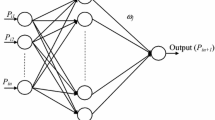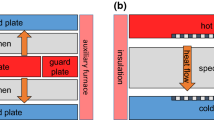Abstract
The analysis of thermogravimetric data of material at multiple heating rates is very labor-intensive and time-consuming. To provide an accurate and effective prediction of the thermogravimetric (TG) curves at various heating rates, this work presents a novel artificial neural network (ANN) framework for cross-heating-rate prediction on the TG curves of commonly used cable insulation materials. The proposed ANN framework consists of data transformation and division techniques that differ from previous studies. By comparing the actual test results and predicted TG results of polyvinyl chloride (PVC), the effectiveness of the proposed ANN framework in the cross-heating-rate prediction of TG curves is validated. By which, the relationship between heating rates and conversion rates can be reliably captured, demonstrating the capability of the proposed ANN framework in interpreting cross-heating-rate TG data. In addition to PVC, the proposed ANN framework has been extended to analyze the TG curves of XLPE.








Similar content being viewed by others
References
Chen RY, Lu SX, Zhang Y, Lo SM. Pyrolysis study of waste cable hose with thermogravimetry/Fourier transform infrared/mass spectrometry analysis. Energy Convers Manag. 2017;153:83–92. https://doi.org/10.1016/j.enconman.2017.09.071.
Wang Z, Wang J. Comparative thermal decomposition characteristics and fire behaviors of commercial cables. J Therm Anal Calorim. 2021;144(4):1209–18. https://doi.org/10.1007/s10973-020-10051-z.
Xie Q, Zhang H, Tong L. Experimental study on the fire protection properties of PVC sheath for old and new cables. J Hazard Mater. 2010;179(1–3):373–81. https://doi.org/10.1016/j.jhazmat.2010.03.015.
Huang XY, Nakamura Y. A review of fundamental combustion phenomena in wire fires. Fire Technol. 2020;56(1):315–60. https://doi.org/10.1007/s10694-019-00918-5.
He H, Zhang QX, Tu R, Zhao LY, Liu J, Zhang YM. Molten thermoplastic dripping behavior induced by flame spread over wire insulation under overload currents. J Hazard Mater. 2016;320:628–34. https://doi.org/10.1016/j.jhazmat.2016.07.070.
Courty L, Garo JP. External heating of electrical cables and auto-ignition investigation. J Hazard Mater. 2017;321:528–36. https://doi.org/10.1016/j.jhazmat.2016.09.042.
Meinier R, Sonnier R, Zavaleta P, Suard S, Ferry L. Fire behavior of halogen-free flame retardant electrical cables with the cone calorimeter. J Hazard Mater. 2018;342:306–16. https://doi.org/10.1016/j.jhazmat.2017.08.027.
Parise G, Hesla E, Mardegan CS, Parise L, Capaccini EB. Measures to minimize series faults in electrical cords and extension cords. IEEE Trans Ind Appl. 2019;55(5):4551–6. https://doi.org/10.1109/tia.2019.2926240.
Kerekes Z, Restas A, Lubloy E. The effects causing the burning of plastic coatings of fire-resistant cables and its consequences. J Therm Anal Calorim. 2020;139(2):775–87. https://doi.org/10.1007/s10973-019-08526-9.
Mo SJ, Zhang J, Liang D, Chen HY. Study on Pyrolysis Characteristics of Cross-linked Polyethylene Material Cable. In: Yao HW, editor. 2012 International Conference on Performance-Based Fire and Fire Protection Engineering. Procedia Engineering, 2013. p. 588–92.
Hanley TL, Burford RP, Fleming RJ, Barber KW. A general review of polymeric insulation for use in HVDC cables. IEEE Electr Insul Mag. 2003;19(1):13–24. https://doi.org/10.1109/mei.2003.1178104.
Wang Z, Wei R, Wang X, He J, Wang J. Pyrolysis and combustion of polyvinyl chloride (PVC) sheath for new and aged cables via thermogravimetric analysis-fourier transform infrared (TG-FTIR) and calorimeter. Materials. 2018. https://doi.org/10.3390/ma11101997.
Wang CJ, Liu HR, Zhang JQ, Yang SL, Zhang Z, Zhao WP. Thermal degradation of flame-retarded high-voltage cable sheath and insulation via TG-FTIR. J Anal Appl Pyrol. 2018;134:167–75. https://doi.org/10.1016/j.jaap.2018.06.005.
Du Y, Jiang X, Lv G, Jin Y, Wang F, Chi Y, et al. TG-DSC and FTIR study on pyrolysis of irradiation cross-linked polyethylene. J Mater Cycles Waste Manag. 2017;19(4):1400–4. https://doi.org/10.1007/s10163-016-0530-z.
Wang Z, Xie T, Ning X, Liu Y, Wang J. Thermal degradation kinetics study of polyvinyl chloride (PVC) sheath for new and aged cables. Waste Manag. 2019;99:146–53. https://doi.org/10.1016/j.wasman.2019.08.042.
Benes M, Milanov N, Matuschek G, Kettrup A, Placek V, Balek V. Thermal degradation of PVC cable insulation studied by simultaneous TG-FTIR and TG-EGA methods. J Therm Anal Calorim. 2004;78(2):621–30. https://doi.org/10.1023/B:JTAN.0000046123.59857.ad.
Marcilla A, Beltran M. Thermogravimetric kinetic-study of poly(vinyl chloride) pyrolysis. Polym Degrad Stab. 1995;48(2):219–29. https://doi.org/10.1016/0141-3910(95)00050-v.
Ohrbach KH, Radhoff G, Kettrup A. Investigations of the thermal-decomposition of PVC cable material by means of simultaneous TG-DTG-DTA-MS analysis. Thermochim Acta. 1985;85:403–6.
Vyazovkin S, Burnham AK, Criado JM, Perez-Maqueda LA, Popescu C, Sbirrazzuoli N. ICTAC kinetics committee recommendations for performing kinetic computations on thermal analysis data. Thermochim Acta. 2011;520(1–2):1–19. https://doi.org/10.1016/j.tca.2011.03.034.
Friedman HL. Kinetics of thermal degradation of char-forming plastics from thermogravimetry. Application to a phenolic plastic. J Polym Sci Part C Polym Symp. 1964;6(1):183–95. https://doi.org/10.1002/polc.5070060121.
Flynn JH, Wall LA. A quick, direct method for the determination of activation energy from thermogravimetric data. J Polym Sci Part C Polym Lett. 1966;4(5):323–8. https://doi.org/10.1002/pol.1966.110040504.
Ozawa T. A new method of analyzing thermogravimetric data. Bull Chem Soc Jpn. 1965;38(11):1881. https://doi.org/10.1246/bcsj.38.1881.
Akahira T, Sunose T. Method of determining activation deterioration constant of electrical insulating materials. Res Rep Chiba Inst Technol (Sci Technol). 1971;1971(16):22–31.
Kissinger HE. Reaction kinetics in differential thermal analysis. Anal Chem. 1957;29(11):1702–6. https://doi.org/10.1021/ac60131a045.
Starink MJ. The determination of activation energy from linear heating rate experiments: a comparison of the accuracy of isoconversion methods. Thermochim Acta. 2003;404(1–2):163–76. https://doi.org/10.1016/s0040-6031(03)00144-8.
Coats AW, Redfern JP. Kinetic parameters from thermogravimetric data. Nature. 1964;201(491):68–000. https://doi.org/10.1038/201068a0.
Sanchez-Jimenez PE, Perez-Maqueda LA, Perejon A, Criado JM. Generalized master plots as a straightforward approach for determining the kinetic model: the case of cellulose pyrolysis. Thermochim Acta. 2013;552:54–9. https://doi.org/10.1016/j.tca.2012.11.003.
Muravyev NV, Luciano G, Ornaghi HL, Svoboda R, Vyazovkin S. Artificial neural networks for pyrolysis, thermal analysis, and thermokinetic studies: the status quo. Molecules. 2021;26(12):3727.
Bezerra EM, Bento MS, Rocco J, Iha K, Lourenco VL, Pardini LC. Artificial neural network (ANN) prediction of kinetic parameters of (CRFC) composites. Comput Mater Sci. 2008;44(2):656–63. https://doi.org/10.1016/j.commatsci.2008.05.002.
Chen JC, Liu JY, He Y, Huang LM, Sun SY, Sun J, et al. Investigation of co-combustion characteristics of sewage sludge and coffee grounds mixtures using thermogravimetric analysis coupled to artificial neural networks modeling. Bioresour Technol. 2017;225:234–45. https://doi.org/10.1016/j.biortech.2016.11.069.
Kuang DY, Xu B. Predicting kinetic triplets using a 1d convolutional neural network. Thermochim Acta. 2018;669:8–15. https://doi.org/10.1016/j.tca.2018.08.024.
Naqvi SR, Tariq R, Hameed Z, Ali I, Taqvi SA, Naqvi M, et al. Pyrolysis of high-ash sewage sludge: thermo-kinetic study using TGA and artificial neural networks. Fuel. 2018;233:529–38. https://doi.org/10.1016/j.fuel.2018.06.089.
Buyukada M. Investigation of thermal conversion characteristics and performance evaluation of co-combustion of pine sawdust and lignite coal using TGA, artificial neural network modeling and likelihood method. Bioresour Technol. 2019;287:8. https://doi.org/10.1016/j.biortech.2019.121461.
Zhang JH, Liu JY, Evrendilek F, Zhang XC, Buyukada M. TG-FTIR and Py-GC/MS analyses of pyrolysis behaviors and products of cattle manure in CO2 and N2 atmospheres: kinetic, thermodynamic, and machine-learning models. Energy Convers Manag. 2019;195:346–59. https://doi.org/10.1016/j.enconman.2019.05.019.
Bi HB, Wang CX, Lin QZ, Jiang XD, Jiang CL, Bao L. Combustion behavior, kinetics, gas emission characteristics and artificial neural network modeling of coal gangue and biomass via TG-FTIR. Energy. 2020;213:13. https://doi.org/10.1016/j.energy.2020.118790.
Dubdub I, Al-Yaari M. Pyrolysis of low density polyethylene: kinetic study using TGA data and ANN prediction. Polymers. 2020;12(4):14. https://doi.org/10.3390/polym12040891.
Bi HB, Wang CX, Jiang XD, Jiang CL, Bao L, Lin QZ. Thermodynamics, kinetics, gas emissions and artificial neural network modeling of co-pyrolysis of sewage sludge and peanut shell. Fuel. 2021;284:12. https://doi.org/10.1016/j.fuel.2020.118988.
Bi HB, Wang CX, Lin QZ, Jiang XD, Jiang CL, Bao L. Pyrolysis characteristics, artificial neural network modeling and environmental impact of coal gangue and biomass by TG-FTIR. Sci Total Environ. 2021;751:12. https://doi.org/10.1016/j.scitotenv.2020.142293.
Chen ZY, Chen HS, Wu XY, Zhang JH, Evrendilek DE, Liu JY, et al. Temperature- and heating rate-dependent pyrolysis mechanisms and emissions of Chinese medicine residues and numerical reconstruction and optimization of their non-linear dynamics. Renew Energy. 2021;164:1408–23. https://doi.org/10.1016/j.renene.2020.10.095.
Karlik B, Olgac AV. Performance analysis of various activation functions in generalized MLP architectures of neural networks. Int J Artif Intell Expert Syst. 2011;1(4):111–22.
Bowden GJ, Dandy GC, Maier HR. Data transformation for neural network models in water resources applications. J Hydroinf. 2003;5(4):245–58. https://doi.org/10.2166/hydro.2003.0021.
Yin BB, Liew KM. Machine learning and materials informatics approaches for evaluating the interfacial properties of fiber-reinforced composites. Compos Struct. 2021;273:12. https://doi.org/10.1016/j.compstruct.2021.114328.
Alaba PA, Popoola SI, Abnisal F, Lee CS, Ohunakin OS, Adetiba E, et al. Thermal decomposition of rice husk: a comprehensive artificial intelligence predictive model. J Therm Anal Calorim. 2020;140(4):1811–23. https://doi.org/10.1007/s10973-019-08915-0.
Acknowledgements
This study was supported by “the Fundamental Research Funds for the Central Universities under Grant No. WK2320000050” and the Research Grants Council of the Hong Kong Special Administrative Region, China (Project No. 9043135, CityU 11202721).
Author information
Authors and Affiliations
Contributions
All authors contributed to the study conception and design. The first draft of the manuscript was written by Yalong Wang. The experiment was done by Yalong Wang and Ning Kang. Jin Lin, Shouxiang Lu, Kim Meow Liew commented on previous versions of the manuscript. All authors read and approved the final manuscript.
Corresponding authors
Ethics declarations
Conflict of interest
The authors declare that they have no conflict of interest.
Additional information
Publisher's Note
Springer Nature remains neutral with regard to jurisdictional claims in published maps and institutional affiliations.
Supplementary Information
Below is the link to the electronic supplementary material.
Rights and permissions
Springer Nature or its licensor holds exclusive rights to this article under a publishing agreement with the author(s) or other rightsholder(s); author self-archiving of the accepted manuscript version of this article is solely governed by the terms of such publishing agreement and applicable law.
About this article
Cite this article
Wang, Y., Kang, N., Lin, J. et al. Cross-heating-rate prediction of thermogravimetry of PVC and XLPE cable insulation material: a novel artificial neural network framework. J Therm Anal Calorim 147, 14467–14478 (2022). https://doi.org/10.1007/s10973-022-11635-7
Received:
Accepted:
Published:
Issue Date:
DOI: https://doi.org/10.1007/s10973-022-11635-7




